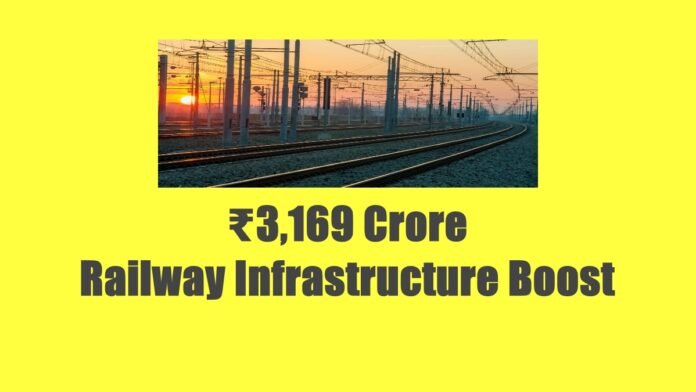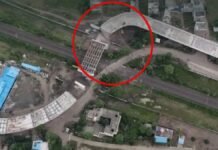
Key Points:
- Cabinet Committee on Economic Affairs approves Bhagalpur-Dumka-Rampurhat railway doubling project worth ₹3,169 crore on September 10, 2025
- 177 km track expansion across Bihar, Jharkhand, and West Bengal will benefit 28.72 lakh people in 441 villages
- Additional freight capacity of 15 MTPA expected for coal, cement, fertilizers, bricks, and stones transportation
- Enhanced connectivity to religious destinations including Deoghar (Baba Baidyanath Dham) and Tarapith (Shakti Peeth)
- Environmental benefits include 5 crore litre reduction in oil imports and CO2 emission cuts equivalent to planting 1 crore trees
New Delhi: The Cabinet Committee on Economic Affairs (CCEA), chaired by Prime Minister Narendra Modi, has given the green light to a transformative railway infrastructure project that promises to revolutionize connectivity across eastern India. The approval for doubling the Bhagalpur-Dumka-Rampurhat single railway line represents one of the most significant rail infrastructure investments in the region, with implications for economic development, religious tourism, and environmental sustainability.
Project Scope and Coverage
The ambitious ₹3,169 crore project spans 177 kilometers across five districts in three states – Bihar, Jharkhand, and West Bengal. Information and Broadcasting Minister Ashwini Vaishnaw, while briefing the media on September 10, 2025, emphasized that this multi-tracking initiative will ease operations and reduce congestion on one of the busiest railway sections in the country.
The project strategically connects major regional centers and will enhance connectivity to approximately 441 villages with a combined population of about 28.72 lakh people. Significantly, the project covers three Aspirational Districts – Banka, Godda, and Dumka – which are part of the government’s focused development program for underperforming districts.
Religious Tourism and Cultural Significance
One of the project’s most notable features is its potential to transform religious tourism in the region. The enhanced railway connectivity will provide improved access to prominent pilgrimage destinations including Deoghar (Baba Baidyanath Dham) – one of the twelve Jyotirlingas sacred to Lord Shiva – and Tarapith (Shakti Peeth) in West Bengal.
These destinations attract millions of pilgrims and tourists from across the country annually, and the doubling project will significantly reduce travel time and improve passenger comfort for devotees visiting these sacred sites.
Economic Impact and Freight Transportation
The project is expected to generate substantial economic benefits through enhanced freight transportation capacity. The route serves as a critical corridor for commodity movement, particularly for coal, cement, fertilizers, bricks, and stones. The capacity augmentation works will result in additional freight traffic of 15 Million Tonnes Per Annum (MTPA).
This increased freight capacity aligns with the region’s emerging industrial profile, particularly the Munger-Jamalpur-Bhagalpur belt in Eastern Bihar, which is developing as a key industrial hub focusing on ordnance factories, locomotive workshops, food processing, and logistics warehousing.
Employment Generation and Economic Development
The project is designed to be a catalyst for comprehensive regional development. It aims to make people of the region “Atmanirbhar” (self-reliant) by enhancing employment and self-employment opportunities. The construction phase alone is expected to generate significant direct and indirect employment, contributing to the local economy during the implementation period.
The initiative aligns with Prime Minister Modi’s vision of a New India and is planned under the PM Gati Shakti National Master Plan, which focuses on enhancing multi-modal connectivity and logistics efficiency through integrated planning and stakeholder consultations.
Environmental Benefits and Sustainability
The project demonstrates the government’s commitment to sustainable transportation solutions. Railways, being an environmentally friendly and energy-efficient mode of transportation, will contribute significantly to climate goals and logistics cost reduction.
The environmental impact assessment reveals impressive sustainability metrics:
- Reduction in oil imports by 5 crore litres annually
- Lower CO2 emissions by 24 crore kg
- Environmental benefit equivalent to planting 1 crore trees
Concurrent Infrastructure Development
Alongside the railway doubling project, the Cabinet also approved the construction of a 4-lane greenfield access-controlled Mokama-Munger section of the Buxar-Bhagalpur High-Speed Corridor in Bihar. This ₹4,447 crore road project spans over 82 kilometers and will be implemented on Hybrid Annuity Mode (HAM).
The highway project will generate approximately 14.83 lakh man-days of direct employment and 18.46 lakh man-days of indirect employment, while providing connectivity to important regional cities including Mokama, Barahiya, Lakhisarai, Jamalpur, and Munger.
Strategic Connectivity Enhancement
The doubling project will create a more efficient transportation corridor between South Bihar and major eastern destinations like Kolkata. Currently, most trains from Bhagalpur travel via Malda Town to reach Rampurhat and onward to Howrah. The new doubled line will enable direct connectivity from Bhagalpur through Dumka to Rampurhat, significantly reducing travel time and operational costs.
This enhanced connectivity is particularly crucial for the movement of people, goods, and services in a region that has historically faced connectivity challenges due to its geographical location across state boundaries.
Implementation Timeline and Future Impact
While specific implementation timelines were not announced, the project represents a significant step forward in the expansion of the Indian Railways network by 177 kilometers. The initiative is expected to improve service reliability and operational efficiency while providing the much-needed infrastructural development for one of the busiest railway sections in the country.
The project’s approval reflects the government’s continued focus on infrastructure development as a driver of economic growth, with particular attention to regions that have historically been underserved by modern transportation networks.
















































